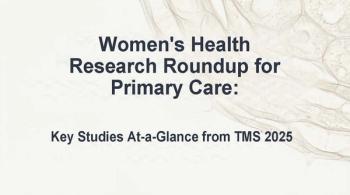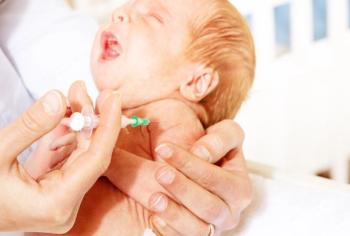
Snakebite
While working in her garden in Virginia, a 40-year-old woman felt a sudden, sharp pain between the fingers of her right h and saw blood coming from an open wound. Immediately, she experienced a burning sensation at the site and noticed numbness and swelling in the hand. The patient was rushed to the emergency department.
While working in her garden in Virginia, a 40-year-old woman felt a sudden, sharp pain between the fingers of her right hand and saw blood coming from an open wound. Immediately, she experienced a burning sensation at the site and noticed numbness and swelling in the hand (A). The patient was rushed to the emergency department.
Dr Jeffrey M. Edmondson, LTC, now of Harket Heights, Tex, writes that this patient had been bitten by a copperhead snake (Agkistrodon contortrix). The patient's husband had killed the 3-foot-long snake (B) and brought it to the hospital, which greatly simplified the diagnosis and treatment.
In the United States, venomous snakes bite approximately 8000 persons each year, but only about 10 victims die. Of venomous snakebites in this country, the 2 major groups that physicians are most likely to encounter are those from the coral snakes (Elapidae) and the pit vipers (Crotalidae). The latter group includes the rattlesnake; copperhead; and water moccasin, or cottonmouth. Snake venoms are chiefly neurotoxic, hemotoxic, or both; pit viper venom is primarily hemotoxic, which accounts for the symptoms seen in this patient.
A variety of factors affect the severity of the bite. These include the type, size, and/or age of the snake; the state of the reptile (eg, angry or hungry); the angle and the depth of the bite; the length of time the snake held onto the victim (the greater the time, the more venom injected); and the time elapsed between bite and treatment. Generally, the larger the snake, the more venom it possesses. Fang marks that are more than 15 mm apart indicate a large, venomous snake.
Other factors include the age of the victim (infants and children are more vulnerable), comorbid conditions (eg, cardiac disease, high blood pressure, coagulation disorders, peptic ulcer disease), location of the bite, and timing of the menstrual cycle. (During the menses, women are at higher risk for bleeding caused by the hemotoxic effects of snake venom.) Bites on the head and trunk are 2 to 3 times more dangerous than those on the extremities because the venom spreads through the circulatory system more rapidly-posing a greater risk of systemic effects, such as disseminated intravascular coagulation. Bites on the upper extremities are more serious than those on the lower extremities.
Signs of envenomation-all of which this patient exhibited-include immediate burning pain at the site, ecchymosis around the fang marks, continuous oozing blood from the bite, and fang marks greater than 15 mm apart. Systemic signs include weakness; sweating; nausea; vomiting; perioral paresthesias; a metallic, minty, or rubbery taste; and/or facial or eyelid fasciculations (myokymic reactions).
Treat all snakebites as potential medical emergencies. Keep the patient calm with the affected limb immobilized in a dependent position during transport to the nearest emergency facility. Measure the circumference of affected extremities every 15 minutes just above the bite and 10 to 20 cm proximal to the bite (C). Avoid using corticosteroids or heparin, and do not apply a tourniquet or cold compresses to an already ischemic area. Urgent fasciotomy is indicated only if there is certain evidence of a true compartment syndrome. Never use mouth suctioning.
Up to 25% of snakebites are dry bites, and no effects of venom are noted. Fifteen percent of bites are characterized as trivial. There is no associated swelling, erythema, or bruising. No treatment is required other than cleansing the area and updating the patient's tetanus immunization. Observe the patient for 8 hours before discharge and follow up as an outpatient.
Classification of the majority of snakebites is determined by the grade of envenomation.
- Grade I: Minimal envenomation occurs in 28% of bites and results in swelling, erythema, and bruising to the immediate area only. No systemic signs or symptoms or laboratory abnormalities are noted. Treatment consists of local cleansing and tetanus prophylaxis; antibiotics and antihistamines may be given as needed.
- Grade II: Twenty percent of bites involve moderate envenomation. The swelling, erythema, and bruising seen in grade I bites spread to the entire extremity. Systemic symptoms-weakness, nausea, vomiting, unusual taste sensations, hypotension, tachycardia, and tachypnea-may be present but usually are not life-threatening. Laboratory coagulation values can be mildly abnormal. Treatment includes the grade I therapies, plus intravenous antivenin (usually fewer than 10 vials) and pain medications (eg, codeine or oxycodone).
- Grade III: Severe envenomation occurs in 12% of bites. In addition to rapidly spreading swelling, erythema, and bruising, victims are in greater pain than those with grade II bites. Respiratory compromise and severe laboratory abnormalities, such as low platelet count, abnormally low fibrinogen levels, and elevated prothrombin time and partial thromboplastin time, may be found. Treatment requires large doses (more than 10 vials) of antivenin; the patient also may need blood products and supportive therapy.
If time permits, order a skin test for horse serum allergy before antivenin is given. If the test is positive, consult the regional poison control center. Give antivenin within the first 4 hours if possible-but preferably not in the field. Antivenin given after 12 hours is of questionable value.
Admit the patient to the ICU if he or she has had a severe envenomation or an anaphylactic reaction, or is receiving antivenin. Antivenin may provoke side effects that can be immediate (anaphylaxis) or delayed (eg, nausea, pruritus, urticaria); these usually respond to antihistamines and corticosteroids. Almost all patients given antivenin experience some form of serum sickness 7 to 12 days later; symptoms may include fever, arthralgias, malaise, edema, urticaria, and lymphadenopathy. These usually resolve gradually with only symptomatic control required.
This patient had moderate envenomation (grade II). She required 10 vials of antivenin. After 2 days in the hospital, the patient was discharged with minimal swelling and no loss of function. Mild serum sickness developed, which resolved after several months. She has resumed her gardening with heightened vigilance for unwanted visitors.
Newsletter
Enhance your clinical practice with the Patient Care newsletter, offering the latest evidence-based guidelines, diagnostic insights, and treatment strategies for primary care physicians.















































































































































































































































































